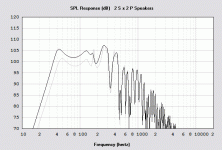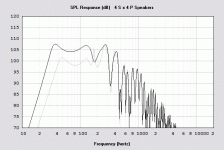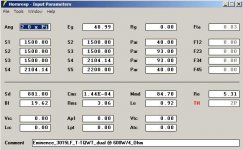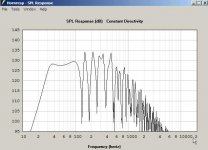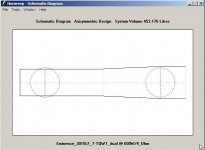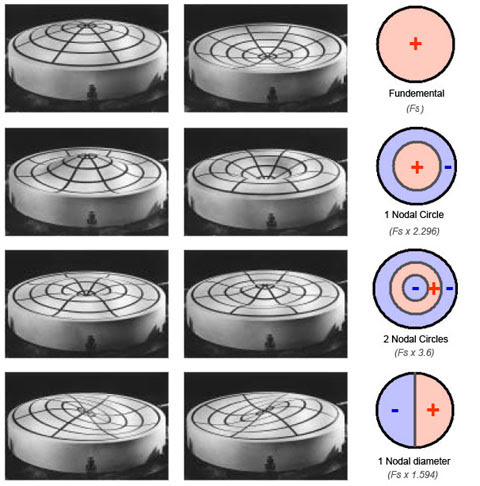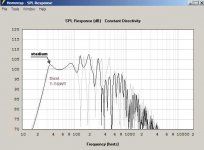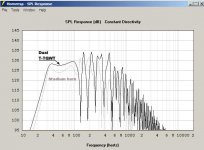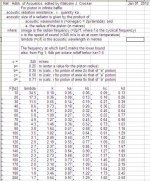As far as SPL is concerned, there is no maximum limit 
I don't need to cross over crazy high or anything - 80, 90Hz is fine
If each cab could reach about 126dB+, that'd be nice - but, I know I'm quite limited (low frequency wise) with the fairly high Fs of these drivers.
I think jbell's Stadiumhorns get the closest for the task - they're just very large. Not his fault - the 3015LFs love a big box to play low, unfortunately.
I don't need to cross over crazy high or anything - 80, 90Hz is fine
If each cab could reach about 126dB+, that'd be nice - but, I know I'm quite limited (low frequency wise) with the fairly high Fs of these drivers.
I think jbell's Stadiumhorns get the closest for the task - they're just very large. Not his fault - the 3015LFs love a big box to play low, unfortunately.
The FuryBox (Furysub) isn’t correct in the table. The numbers are based on an old HornResp that I haven’t checked yet on accuracy. If I look to ScreamerUSA’s measurement response on his website it looks more in the order off 42Hz +/-3dB.
With the Eminence 3015LF it is not possible to reach 126dB in a TH with decent low end. The drivers Xmax is mathematically correct but in reality the motor isn’t sufficient enough to make the VC even reach the Xmax. Besides, the cone suffers from serious Dynamic Compression at max load. The so called 'new' version is even worse compared to the 'old' version on which most TH designs are based.
With the Eminence 3015LF it is not possible to reach 126dB in a TH with decent low end. The drivers Xmax is mathematically correct but in reality the motor isn’t sufficient enough to make the VC even reach the Xmax. Besides, the cone suffers from serious Dynamic Compression at max load. The so called 'new' version is even worse compared to the 'old' version on which most TH designs are based.
Last edited:
Hi Ben, Several members here on DIY have mentioned the same findings and also for other Eminence drivers like the Lab series. For Europeans I really don't understand why they buy 3015LF's since there are better options for a similar price.When did you become so disappointed by the 3015lf.
- did you reach this conclusion in your own testing - if so, what enclosure?
- has data been published about this?
Regards, Ben
The reason why the RCF L15P200AK sounds less loud in a one on one test is because of its higher Re (this counts for more drivers). But with a decent amp it will be at least 2dB louder in max SPL. Remember most sims are based on 2,83V instead of 1W/1m.
Last edited:
Hi Ben, Several members here on DIY have mentioned the same findings and also for other Eminence drivers like the Lab series. For Europeans I really don't understand why they buy 3015LF's since there are better options for a similar price.
The reason why the RCF L15P200AK sounds less loud in a one on one test is because of its higher Re (this counts for more drivers). But with a decent amp it will be at least 2dB louder in max SPL. Remember most sims are based on 2,83V instead of 1W/1m.
I got sucked in to using the 3015lf when it was cheap (and when I started building cabinets using BFM plans) - with a discount and no sales tax, they were 137 Euro a piece when I bought them, and I still have 6 good ones.
JBELL - whose designs and advice I have come to respect - warned me not to exceed 200 Watts per driver in my 20 Hz tapped horns. That is an indication of their limitations!
Regards, Ben
Jim is quiet conservative when it comes to powering but I can't blame him. Btw I don't like driving any speaker below its Fs when it comes to PA. I don't say you shouldn't or you can't but it delivers always low max SPL figures and often makes the cone excursion max at the Fs of the driver. That means extra cone losses at max SPL. But the concept of cone losses is not really discussed around here. I always try to design in such way that the -3dB point falls together with the 1/3WL and just above the Fs of the driver. That gives you the max efficiency from that driver and puts the excursion dip on the Fs of the driver. That the reason why the JBells SS15, Xoc1-TH18-2, Martinsson's Tham and Danley's TH118 for instance are so brilliant in my eyes.I got sucked in to using the 3015lf when it was cheap (and when I started building cabinets using BFM plans) - with a discount and no sales tax, they were 137 Euro a piece when I bought them, and I still have 6 good ones.
JBELL - whose designs and advice I have come to respect - warned me not to exceed 200 Watts per driver in my 20 Hz tapped horns. That is an indication of their limitations! Regards, Ben
Fs
This makes me wonder - are there actually drivers with an Fs low enough to make a really good PA subwoofer that goes down to 20, or is this simply unrealistic? Even expensive 21 inch woofers have Fs around 30 Hz!
Regards, Ben
Jim is quiet conservative when it comes to powering but I can't blame him. Btw I don't like driving any speaker below its Fs when it comes to PA. I don't say you shouldn't or you can't but it delivers always low max SPL figures and often makes the cone excursion max at the Fs of the driver. That means extra cone losses at max SPL. But the concept of cone losses is not really discussed around here. I always try to design in such way that the -3dB point falls together with the 1/3WL and just above the Fs of the driver. That gives you the max efficiency from that driver and puts the excursion dip on the Fs of the driver. That the reason why the JBells SS15, Xoc1-TH18-2, Martinsson's Tham and Danley's TH118 for instance are so brilliant in my eyes.
This makes me wonder - are there actually drivers with an Fs low enough to make a really good PA subwoofer that goes down to 20, or is this simply unrealistic? Even expensive 21 inch woofers have Fs around 30 Hz!
Regards, Ben
Those of us that have actually measured single TH against multiples have found the low corner does not change as it does for FLH in multiples.
Going from one to four cabinets with the same voltage drive gives a 12 dB increase in level, and the increased frontal area provides greater directivity, which can add even more level on axis.
Those level increases make it easy to think the low corner has gone lower, but so far I have not seen any actual measurements showing that to be the case.
Art Welter
OK, just so I'm clear since I still haven't built/measured a TH; you're saying that this simmed ~6 Hz downward shift of a single Vs 2S-2P and the ~12 Hz Vs 4S-4P [eg = 2.83 V, 2 pi] is all due to increased on -axis directivity? Or is HR being overly optimistic?
TIA,
GM
Attachments
Hi Y'all,
You have been busy, just some observations:
1. Post #1217: There was an update to the Furysub drawing: see Post #535 for the updated drawing http://www.diyaudio.com/forums/subwoofers/131852-live-sound-specific-tapped-horn-thread-54.html, there is a lot of subsequent discussion; see #563 for my attempt at an AkAbak simulation; there never was any resolution as to the lack of agreement between screamer's measurement, and the Hornresp SPL derived from the drawing.
2. I don't believe that a tapped horn - optimized for the low end capabilty of the driver - ends up with the driver's Fs below the speaker's passband. On the contrary, the Fs should be in the passband if you are looking for low end extension. The 3015LF just happens to call for a big box (see stadium horn), and it works just fine as long as the box is big enough. The SS15 is optimized for a reduced low end and high output, but not for the driver's low end capability (that's where you get to the stadium horn, or larger).
3. It may just be my mistaken impression, but I have noticed a tendency in the PA world for people to overdrive and just generally abuse their speakers. Keep the power and the Xmax below manufacturer's ratings, and use adequate low-cut filters. I don't think jbell is conservative (well, he may be) just technically correct.
4. As an alternative for Crescendo: how about going the route that justin went with bjorno's T-TQWT? Maybe as a dual, a very easy build, and not as big as a tapped horn. Doesn't look like that would be hard to try.
Happy New Year Y'all.
You have been busy, just some observations:
1. Post #1217: There was an update to the Furysub drawing: see Post #535 for the updated drawing http://www.diyaudio.com/forums/subwoofers/131852-live-sound-specific-tapped-horn-thread-54.html, there is a lot of subsequent discussion; see #563 for my attempt at an AkAbak simulation; there never was any resolution as to the lack of agreement between screamer's measurement, and the Hornresp SPL derived from the drawing.
2. I don't believe that a tapped horn - optimized for the low end capabilty of the driver - ends up with the driver's Fs below the speaker's passband. On the contrary, the Fs should be in the passband if you are looking for low end extension. The 3015LF just happens to call for a big box (see stadium horn), and it works just fine as long as the box is big enough. The SS15 is optimized for a reduced low end and high output, but not for the driver's low end capability (that's where you get to the stadium horn, or larger).
3. It may just be my mistaken impression, but I have noticed a tendency in the PA world for people to overdrive and just generally abuse their speakers. Keep the power and the Xmax below manufacturer's ratings, and use adequate low-cut filters. I don't think jbell is conservative (well, he may be) just technically correct.
4. As an alternative for Crescendo: how about going the route that justin went with bjorno's T-TQWT? Maybe as a dual, a very easy build, and not as big as a tapped horn. Doesn't look like that would be hard to try.
Happy New Year Y'all.
Attachments
Hi Oliver,
I quote myself: “I always try to design in such way that the -3dB point falls together with the 1/3WL and just above the Fs of the driver.” To me, that means the Fs falls between 1/4WL and 1/3WL and is therefore within the bandpass.
I also stated: “I don't say you shouldn't or you can't”.
It’s not like a golden rule but 'accidentally' all designs with an sensitivity of >98dB and with usable volumes, seem to have it that way, Danley's notorious TH118 included.
As far as PA people, 'they' just don’t like T/S parameters that don’t hold up in reality. Driving your LF drivers up to Xmax is not a luxury but a common thing for PA. This is where PA and other sectors differ, I think. Every respected PA driver manufacturer uses certain over excursion possibility that is in ratio with the Xlim and peak power (crest factor, AES standards). Respectable Pro Sound System manufacturers don’t support brands that don’t meet up with these standards/expectations. Of course that is a different view from many DIY's for whom price/performance is often more important. Just a matter of differences and for each one there is something to say.
Happy new year to you also and all DIY members!
I quote myself: “I always try to design in such way that the -3dB point falls together with the 1/3WL and just above the Fs of the driver.” To me, that means the Fs falls between 1/4WL and 1/3WL and is therefore within the bandpass.
I also stated: “I don't say you shouldn't or you can't”.
It’s not like a golden rule but 'accidentally' all designs with an sensitivity of >98dB and with usable volumes, seem to have it that way, Danley's notorious TH118 included.
As far as PA people, 'they' just don’t like T/S parameters that don’t hold up in reality. Driving your LF drivers up to Xmax is not a luxury but a common thing for PA. This is where PA and other sectors differ, I think. Every respected PA driver manufacturer uses certain over excursion possibility that is in ratio with the Xlim and peak power (crest factor, AES standards). Respectable Pro Sound System manufacturers don’t support brands that don’t meet up with these standards/expectations. Of course that is a different view from many DIY's for whom price/performance is often more important. Just a matter of differences and for each one there is something to say.
Happy new year to you also and all DIY members!
Last edited:
Originally Posted by weltersys
Those of us that have actually measured single TH against multiples have found the low corner does not change as it does for FLH in multiples.
Going from one to four cabinets with the same voltage drive gives a 12 dB increase in level, and the increased frontal area provides greater directivity, which can add even more level on axis.
Those level increases make it easy to think the low corner has gone lower, but so far I have not seen any actual measurements showing that to be the case.
Art Welter
On axis directivity increases more in multiples at upper frequencies than lower, so even if Hornresp took directivity into account, the result should be more upper frequency (around 100 Hz) on axis SPL increase rather than more LF.
My actual tests with one TH compared to two show the response goes lower only by a minute amount, and that amount hardly changes when the second cabinet is unpowered and shorted.
Tom Danley or Ivan Beaver have posted charts of the TH-115 with one, two and four, the low corner hardly changes at all.
Typical TH behave more like a BR (which hardly go lower in LF corner in multiples) than FLH, which do go lower in low corner and level in multiples.
Art
Those of us that have actually measured single TH against multiples have found the low corner does not change as it does for FLH in multiples.
Going from one to four cabinets with the same voltage drive gives a 12 dB increase in level, and the increased frontal area provides greater directivity, which can add even more level on axis.
Those level increases make it easy to think the low corner has gone lower, but so far I have not seen any actual measurements showing that to be the case.
Art Welter
My observation is that HR is overly optimistic in predicting a downward shift of the low corner in TH response.OK, just so I'm clear since I still haven't built/measured a TH; you're saying that this simmed ~6 Hz downward shift of a single Vs 2S-2P and the ~12 Hz Vs 4S-4P [eg = 2.83 V, 2 pi] is all due to increased on -axis directivity? Or is HR being overly optimistic?
TIA,
GM
On axis directivity increases more in multiples at upper frequencies than lower, so even if Hornresp took directivity into account, the result should be more upper frequency (around 100 Hz) on axis SPL increase rather than more LF.
My actual tests with one TH compared to two show the response goes lower only by a minute amount, and that amount hardly changes when the second cabinet is unpowered and shorted.
Tom Danley or Ivan Beaver have posted charts of the TH-115 with one, two and four, the low corner hardly changes at all.
Typical TH behave more like a BR (which hardly go lower in LF corner in multiples) than FLH, which do go lower in low corner and level in multiples.
Art
Last edited:
Hi Y'all,
You have been busy, just some observations:
1. Post #1217: There was an update to the Furysub drawing: see Post #535 for the updated drawing http://www.diyaudio.com/forums/subwoofers/131852-live-sound-specific-tapped-horn-thread-54.html, there is a lot of subsequent discussion; see #563 for my attempt at an AkAbak simulation; there never was any resolution as to the lack of agreement between screamer's measurement, and the Hornresp SPL derived from the drawing.
Thanks for the links. Makes it easier to steer in the right direction.
2. I don't believe that a tapped horn - optimized for the low end capabilty of the driver - ends up with the driver's Fs below the speaker's passband. On the contrary, the Fs should be in the passband if you are looking for low end extension. The 3015LF just happens to call for a big box (see stadium horn), and it works just fine as long as the box is big enough. The SS15 is optimized for a reduced low end and high output, but not for the driver's low end capability (that's where you get to the stadium horn, or larger).
4. As an alternative for Crescendo: how about going the route that justin went with bjorno's T-TQWT? Maybe as a dual, a very easy build, and not as big as a tapped horn. Doesn't look like that would be hard to try.
Happy New Year Y'all.
This is actually making me think a bit (in a good way)
I think the fact that 2 stadiumhorns may be 4-5dB louder than this dual from 30Hz-up is where I'm playing tug-of-war. My thinking is getting the most energy out of the drivers I have from a reasonable size - stadiumhorn being on the fence of reasonable. Maybe you can help me think this through: In the end, the 6 stadiumhorns would provide more energy. For bigger shows, this is a definite plus. I typically have a Sprinter van (tall & long) for transport, so size, while being a concern isn't the biggest concern. Maybe if the dual T-TQWT was 3-4dB or so more sensitive it would be enough to justify using 2 drivers in 1 enclosure (instead of using those 2 drivers in 2 stadiumhorns and gaining almost twice the energy). Sorry if I'm being difficult.
Hope you all have a safe and amazing New Year!!

Hi Oliver,
Sorry, but it looks like I owe you one. I see now my text in post #1226 was in contradiction. Anyhow, the context is not changed over the last year and I really think that the Fs should fall below 1/3WL and above 1/4WL of a tapped horn, optimised for PA. Somehow that turns in the best balance between low end, high sensitivity, box dimensions and max SPL. The second reason is to suppress cone losses, more specifically those within the cone.
If the Fs of a driver falls just above 1/3WL, the higher resonances in the cone (4 diagonal nodals) often meet
the full wavelength resonance of the TH system. If they do, it can result in cone damage at max settings. Less obvious but also something to consider, it can change the suspension over time. That's why I don't like foam type surrounds for PA subs as all resonances have to be dealt with by the spider. That these points of the driver and a system fall together is nothing new. 'Old' drivers with untreated cones and low mass suffered a lot from them during the golden age of FLH's. People often identify it with over excursion but that is actually a wrong assumption.
Over excursion always leaves certain marks and will be very audible by the user. Sudden death or sudden drop in SPL, besides hammering or scrapping sounds of the VC former against one of the plates, are caused by over excursion. The effects from resonances within the cone before it gets damaged are often not heard by the end user. By the time they become audible, it is often already too late and the cones are already damaged, if not destroyed.
Nodals, circle and diagonal in form, only happen when the suspension is no longer able to absorb the energy from these cone resonances. For TH’s there is an extra point of attention since the cone hasn’t a 'compressed air spring’ from a closed back, like in traditional FLH’s. In other words in TH’s the suspension has to deal completely with resonances and losses by the cone (Dynamic Compression). This is where the differences in concepts and differences in quality between drivers become obvious.
I have attached an overview of most important cone resonances that can be used to optimise TH’s for PA. Hopefully I didn’t make too many mistakes this time, but if I did, let me know.

The pluses and minuses represent the direction of cone parts in relation to the first half of the waveform of the resonance.
Sorry, but it looks like I owe you one. I see now my text in post #1226 was in contradiction. Anyhow, the context is not changed over the last year and I really think that the Fs should fall below 1/3WL and above 1/4WL of a tapped horn, optimised for PA. Somehow that turns in the best balance between low end, high sensitivity, box dimensions and max SPL. The second reason is to suppress cone losses, more specifically those within the cone.
If the Fs of a driver falls just above 1/3WL, the higher resonances in the cone (4 diagonal nodals) often meet
the full wavelength resonance of the TH system. If they do, it can result in cone damage at max settings. Less obvious but also something to consider, it can change the suspension over time. That's why I don't like foam type surrounds for PA subs as all resonances have to be dealt with by the spider. That these points of the driver and a system fall together is nothing new. 'Old' drivers with untreated cones and low mass suffered a lot from them during the golden age of FLH's. People often identify it with over excursion but that is actually a wrong assumption.
Over excursion always leaves certain marks and will be very audible by the user. Sudden death or sudden drop in SPL, besides hammering or scrapping sounds of the VC former against one of the plates, are caused by over excursion. The effects from resonances within the cone before it gets damaged are often not heard by the end user. By the time they become audible, it is often already too late and the cones are already damaged, if not destroyed.
Nodals, circle and diagonal in form, only happen when the suspension is no longer able to absorb the energy from these cone resonances. For TH’s there is an extra point of attention since the cone hasn’t a 'compressed air spring’ from a closed back, like in traditional FLH’s. In other words in TH’s the suspension has to deal completely with resonances and losses by the cone (Dynamic Compression). This is where the differences in concepts and differences in quality between drivers become obvious.
I have attached an overview of most important cone resonances that can be used to optimise TH’s for PA. Hopefully I didn’t make too many mistakes this time, but if I did, let me know.

The pluses and minuses represent the direction of cone parts in relation to the first half of the waveform of the resonance.
Last edited:
Hi Crescendo,
There are always more questions, aren't there?
For maximum output with low end extension to 30Hz, and without regard to the size it's the stadium horn.
Using Don Snyder's data: the stadium horn is 48"H x 25.44"W x 36"D, that's 720.4 L_external. In Hornresp - with the segments set to Par - the volume is given as 606.824 L_net. When you take a look at the Hornresp simulation, you will see that this horn can be tweaked a little to smoothen out the response, and to reduce the size a little bit, but it's pretty close as it is. Unlike the SS15 this one does not look like jbell spend a lot of extra time refining it, but it still came out fine.
The stadium horn will reach 11.6mm displacement @ 260W into 8 Ohm (Eg=45.61V) @ 41Hz. The T-TQWT Dual will reach 11.4mm displacement @ 600W into 4 Ohm (Eg=48.99V) @ 42Hz. I'm attaching Hornresp Spl response screens at these levels and at 1W. Depending on which frequency you pick the T-TQWT Dual is quite a bit louder (at a bit more than twice the input power) at that excursion level.
I have not drawn the T-TQWT (for the external volume), but it seems simple enough. In Hornresp the net volume is 453.176 L_net. That's a good 150 L smaller than the stadium horn (or 921.9 L_net for 6ea.). So you're trading of volume for a second driver and roughly twice the required power, but you're gaining 3 to 4 dB more output and a flatter response (in the simulation).
And then there is the question, what does it sound like, and how does it project? Would one be better for outdoors, and the other better for indoors? And so on....
Regards,
There are always more questions, aren't there?
For maximum output with low end extension to 30Hz, and without regard to the size it's the stadium horn.
Using Don Snyder's data: the stadium horn is 48"H x 25.44"W x 36"D, that's 720.4 L_external. In Hornresp - with the segments set to Par - the volume is given as 606.824 L_net. When you take a look at the Hornresp simulation, you will see that this horn can be tweaked a little to smoothen out the response, and to reduce the size a little bit, but it's pretty close as it is. Unlike the SS15 this one does not look like jbell spend a lot of extra time refining it, but it still came out fine.
The stadium horn will reach 11.6mm displacement @ 260W into 8 Ohm (Eg=45.61V) @ 41Hz. The T-TQWT Dual will reach 11.4mm displacement @ 600W into 4 Ohm (Eg=48.99V) @ 42Hz. I'm attaching Hornresp Spl response screens at these levels and at 1W. Depending on which frequency you pick the T-TQWT Dual is quite a bit louder (at a bit more than twice the input power) at that excursion level.
I have not drawn the T-TQWT (for the external volume), but it seems simple enough. In Hornresp the net volume is 453.176 L_net. That's a good 150 L smaller than the stadium horn (or 921.9 L_net for 6ea.). So you're trading of volume for a second driver and roughly twice the required power, but you're gaining 3 to 4 dB more output and a flatter response (in the simulation).
And then there is the question, what does it sound like, and how does it project? Would one be better for outdoors, and the other better for indoors? And so on....
Regards,
Attachments
Last edited:
On axis directivity increases more in multiples at upper frequencies than lower, so even if Hornresp took directivity into account, the result should be more upper frequency (around 100 Hz) on axis SPL increase rather than more LF.
Typical TH behave more like a BR (which hardly go lower in LF corner in multiples) than FLH, which do go lower in low corner and level in multiples.
Just as theory predicts.
Seems reasonable based on what I know and the TP, TH sims I've typically done in HR show barely a 1 Hz offset from [1] to [8] speakers, but then it turned around and made FLH like predictions with a TH layout that's a bit different than any I've seen posted by others, so it makes me wonder if HR is wrong.
GM
Maybe I should make it more practical... Use 3015lf's in a DJK Push-Pull setting (vertical aligned) in any type of design and you should hear the difference clearly in that they will keep their low end and transients (less compressed) much longer as you step up in power, compared to two single units.
Hi GM and weltersys,
I remembered and took another look at the chart of "Normalized Acoustic Radiation Resistance - piston in an infinite baffle". That should be available in a lot of places. My "library" is still in storage-as I don't seem to be able to get the remodeling finished after the last move-so I found it by googleing "acoustic radiation resistance v." the second entry is the Handbook of Acoustics, Malcolm J. Crocker, P.1390.
I vaguely remember that-a long time ago-I did a series of measurements after reading a comment in the Audiocyclopedia, that doubling of the number of drivers more strongly affects the very low end of a speakers response, than the middle range. Which I took to mean e.g.: @ 50Hz v. @ 500Hz; and, I found this to hold true. In other words: there is a greater increase in SPL if you are on the 6dB slope of the curve (ka<2) than if you are in the horizontal section (ka>2).
From this I conclude, that David McBean's Hornresp is probably correct. I'll leave it up to the experts to crunch the numbers in any particular case as I'm math-challenged, but I'll attach a quick spreadsheet screen print (any corrections are highly welcome):
Regards,
I remembered and took another look at the chart of "Normalized Acoustic Radiation Resistance - piston in an infinite baffle". That should be available in a lot of places. My "library" is still in storage-as I don't seem to be able to get the remodeling finished after the last move-so I found it by googleing "acoustic radiation resistance v." the second entry is the Handbook of Acoustics, Malcolm J. Crocker, P.1390.
I vaguely remember that-a long time ago-I did a series of measurements after reading a comment in the Audiocyclopedia, that doubling of the number of drivers more strongly affects the very low end of a speakers response, than the middle range. Which I took to mean e.g.: @ 50Hz v. @ 500Hz; and, I found this to hold true. In other words: there is a greater increase in SPL if you are on the 6dB slope of the curve (ka<2) than if you are in the horizontal section (ka>2).
From this I conclude, that David McBean's Hornresp is probably correct. I'll leave it up to the experts to crunch the numbers in any particular case as I'm math-challenged, but I'll attach a quick spreadsheet screen print (any corrections are highly welcome):
Regards,
Attachments
- Home
- Loudspeakers
- Subwoofers
- Single sheet TH challenge
